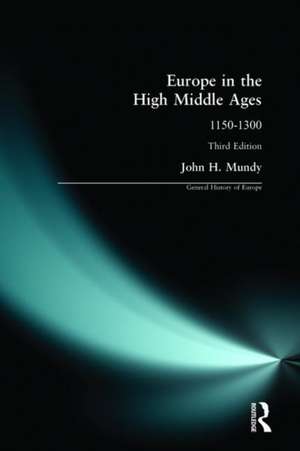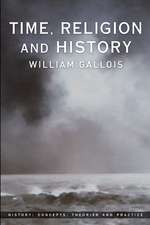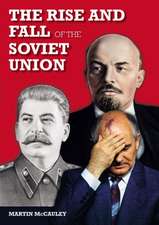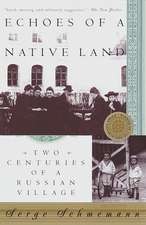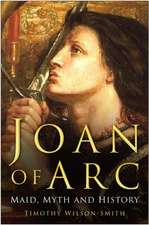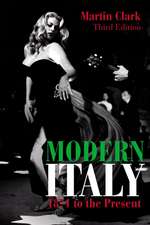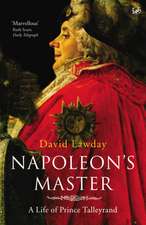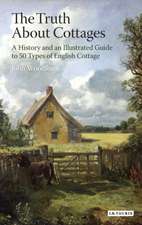Europe in the High Middle Ages: 1150-1300: General History of Europe
Autor John H. Mundyen Limba Engleză Paperback – feb 2000
| Toate formatele și edițiile | Preț | Express |
|---|---|---|
| Paperback (1) | 568.28 lei 6-8 săpt. | |
| Taylor & Francis – feb 2000 | 568.28 lei 6-8 săpt. | |
| Hardback (1) | 1000.27 lei 6-8 săpt. | |
| Taylor & Francis – 13 ian 2017 | 1000.27 lei 6-8 săpt. |
Preț: 568.28 lei
Preț vechi: 668.57 lei
-15% Nou
Puncte Express: 852
Preț estimativ în valută:
108.74€ • 113.84$ • 89.98£
108.74€ • 113.84$ • 89.98£
Carte tipărită la comandă
Livrare economică 05-19 aprilie
Preluare comenzi: 021 569.72.76
Specificații
ISBN-13: 9780582369870
ISBN-10: 0582369878
Pagini: 432
Dimensiuni: 156 x 234 x 21 mm
Greutate: 0.45 kg
Ediția:Revizuită
Editura: Taylor & Francis
Colecția Routledge
Seria General History of Europe
Locul publicării:Oxford, United Kingdom
ISBN-10: 0582369878
Pagini: 432
Dimensiuni: 156 x 234 x 21 mm
Greutate: 0.45 kg
Ediția:Revizuită
Editura: Taylor & Francis
Colecția Routledge
Seria General History of Europe
Locul publicării:Oxford, United Kingdom
Public țintă
UndergraduateCuprins
List of maps x Abbreviations xi Preface xiii 1 Introduction 1 The subject matter, p. 1 – History, biography and poetry, pp. 6–10 PART ONE: EUROPE 2 Social frontiers: clerks and laymen 13 The two peoples, p. 13 – Letters, professions and laicism, pp. 18–24 3 Cultural frontiers: France, Italy and Europe 25 France, p. 25 – Italy, p. 31 – Europe, pp. 34–36 4 Crusades and missions 37 Crusades and European expansion, p. 37 – Missions and toleration, p. 45 – War and missions, pp. 48–50 5 The Jews 51 Divisions and education, p. 51 – Government and economy, p. 54 – Conversion and persecution, pp. 60–66 PART TWO: ECONOMY 6 Foundation and growth 69 The land, p. 69 – The town, p. 73 – Industry and commerce, p. 77 – Planning, building and living standards, pp. 80–89 7 Organization 90 Rural enterprise, p. 90 – Commerce, p. 97 – Business, credit and industry, pp. 101–108 8 Usury and corporatism 109 The prohibition of usury, p. 109 – Economic corporatism, pp. 118–125 PART THREE: SOCIETY 9 Women and men 129 Marriage and love, p. 129 – Means, literacy and religion, pp. 135–142 10 Workers and farmers 143 Farmers, p. 143 – Townsfolk, pp. 152–159 11 Nobles and the military 160 The military, p. 160 – Knighthood, p. 165 – Chivalry and war, pp. 170–176 12 Ecclesiastics 177 Clerical types, p. 177 – Clerical freedom, p. 182 – Clerical rivalries, p. 187 – Clerks and layfolk, pp. 190–195 PART FOUR: GOVERNMENT 13 The Church 199 Power and Crusade, p. 199 – Popes and princes, p. 203 – Local churches, p. 207 – Church government, pp. 212–217 14 The greater monarchies 218 The Empire, p. 218 – England, p. 222 – France, pp. 227–233 15 Princes, senates and assemblies 234 Popes, cardinals and councils, p. 234 – Secular princes and parliaments, pp. 237–244 16 Princes, villages and towns 245 Communities and defence, p. 245 – Village and town, p. 246 – Town and city, pp. 250–254 17 Republics 255 Republican thought, p. 255 – The ‘people’, p. 262 – Princes and oligarchs, pp. 267–272 Europe in the High Middle Ages 18 Government and law 273 Scribes and chanceries, p. 273 – Laws, p. 277 – Lawyers and judges, pp. 281–287 PART FIVE: THOUGHT 19 Intellectuals 291 Schools and universities, p. 291 – Learning and freedom, pp. 296–302 20 Reason and religion 303 History and progress, p. 303 – Science and determinism, p. 309 – Nature and freedom, p. 312 – Deity and certitude, pp. 317–321 21 Enthusiasm and heresy 322 Doubt and heresy, p. 322 – Divergent belief, p. 328 – The ideal world, pp. 333–336 22 Repression 337 Divergence and society, p. 337 – Urban or rural?, p. 342 – Force and repression, pp. 344–352 PART SIX: 1300 23 Church, state and society 355 Lay and papal authority, p. 355 – Ecclesiastical divisions, p. 358 – Lay pressures, pp. 365–370 24 Unam sanctam 371 Polemics, p. 371 – Conclusions, pp. 380–382 Bibliography 383 Maps 395 Index
Descriere
A revised and updated new edition of Professor Mundy's lively introduction to Europe 1150-1300. It provides a portrait of the social, economic, political and intellectual life of Latin Christendom in the period. Wherever possible the men and women of the high middle ages are allowed to speak for themselves as Professor Mundy makes wide use of contemporary sources xxx; bringing alive the complexities and concerns of people living in medieval times. Another strength of the book is the attention devoted to groups often marginalised in other histories xxx; looking at the experience of women, for instance, and that of the Jews in a predominantly Christian society.
